Winter Solstice Dates & Times - Newgrange, Ireland
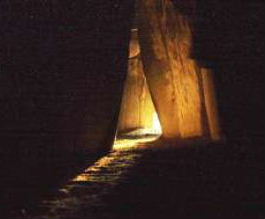 Solstice literally means 'Sun Stands Still', for a few days around the time of the
winter solstice the sun appears
to stand still in the sky in that its elevation at noon does not seem to change.
Solstice literally means 'Sun Stands Still', for a few days around the time of the
winter solstice the sun appears
to stand still in the sky in that its elevation at noon does not seem to change.
The winter solstice date is normally considered to be the 21st of December in the northern hemisphere, however at the winter solstice the position of the sun remains the same for three days.
The following are the winter solstice midpoint dates and times. The time zone used is Coordinated Universal Time (UTC).
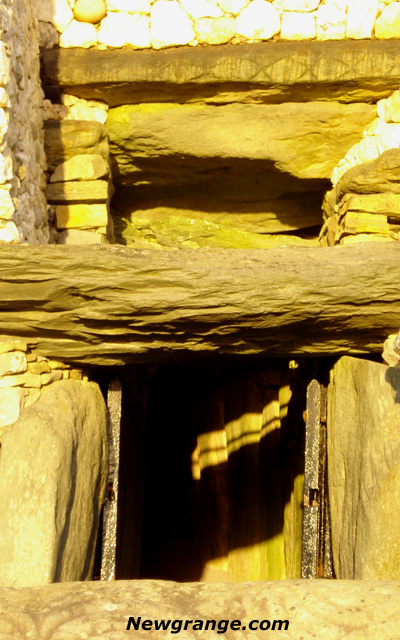
- 2026 - 21st December 15:50 UTC
- 2025 - 21st December 15:03 UTC
- 2024 - 21st December 09:20 UTC
- 2023 - 22nd December 03:27 UTC
- 2022 - 21st December 21:36 UTC
- 2021 - 21st December 15:59 UTC
- 2020 - 21st December 10:02 UTC
- 2019 - 22nd December 04:19 UTC
- 2018 - 21st December 22:23 UTC
- 2017 - 21st December 16:28 UTC
- 2016 - 21st December 10:44 UTC
- 2015 - 22nd December 04:48 UTC
- 2014 - 21st December 23:03 UTC
- 2013 - 21st December 17:11 UTC
- 2012 - 21st December 11:12 UTC
- 2011 - 22nd December 05:30 UTC
- 2010 - 21st December 23:38 UTC
- 2009 - 21st December 17:47 UTC
- 2008 - 21st December 12:04 UTC
- 2007 - 22nd December 06:08 UTC
- 2006 - 22nd December 00:22 UTC
- 2005 - 21st December 18:35 UTC
- 2004 - 21st December 12:42 UTC
- 2003 - 22nd December 07:04 UTC
- 2002 - 22nd December 01:14 UTC
- 2001 - 21st December 19:21 UTC
At Newgrange in Ireland a wonderful event takes place for a few days around the winter solstice each year, the passage and chamber of the 5000 year old monument are illuminated by the winter solstice sunrise. A shaft of sunlight shines through the roof box over the entrance and penetrates the passage to light up the chamber. The dramatic event lasts for 17 minutes at dawn from the 19th to the 23rd of December.
Winter Solstice Dawn at Newgrange
Winter Solstice Dawn at Newgrange, Co. Meath, Ireland
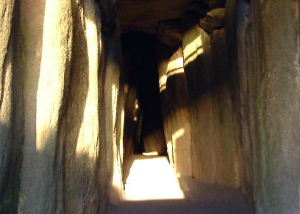 Newgrange Winter Solstice 2004
Newgrange Winter Solstice 2004In 2004 the winter solstice mid point is the 21st December, however the winter solstice sunrise illuminates the passage and chamber at Newgrange for a few days around the mid point.
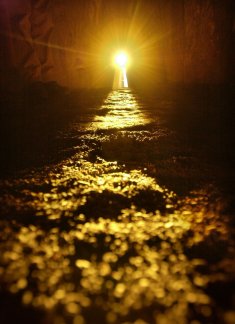 Newgrange
Winter Solstice 2003
Newgrange
Winter Solstice 2003
Curiosity and belief create tradition and custom becomes ritual. This is true of many things, such as the annual mid-winter pilgrimage to the great Stone Age passage grave monument of Newgrange in Brú na Bóinne, the famous Boyne Valley in Co. Meath. During the solstice, the five shortest days of the year, the rising sun will, given kindly weather conditions, strike the northern or back recess of the chamber. Fusing nature and science, with the honouring of the dead, the phenomenon devised 5,000 years ago continues to fascinate.
The Winter Solstice sunrise illuminates the passage way leading into the burial chamber of the megalithic passage tomb at Newgrange on the 21st December 2003. This wonderful photograph by Alan Betson was printed on the front page of the Irish Times newspaper on the 22nd December 2003.
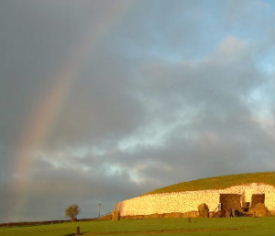 Newgrange Winter Solstice 2002
Newgrange Winter Solstice 2002Images from the Winter Solstice at Newgrange on the 22nd December 2002. A rainbow heightened the experience of those on the outside, as the fortunate few on the inside, selected by lottery experienced the illumination of the passage and chamber.
 Newgrange Winter Solstice 2001
Newgrange Winter Solstice 2001Solstice sunrise lets lucky few gaze through window to an ancient world.
Light at the end of the tunnel: the sun makes its way into the main chamber at Newgrange during the winter solstice yesterday.
Photography by Frank McGrath.
Boyne Valley Private Day Tour
 Immerse yourself in the rich heritage and culture of the Boyne Valley with our full-day private tours.
Visit Newgrange World Heritage site, explore the Hill of Slane, where Saint Patrick famously lit the Paschal fire.
Discover the Hill of Tara, the ancient seat of power for the High Kings of Ireland.
Book Now
Immerse yourself in the rich heritage and culture of the Boyne Valley with our full-day private tours.
Visit Newgrange World Heritage site, explore the Hill of Slane, where Saint Patrick famously lit the Paschal fire.
Discover the Hill of Tara, the ancient seat of power for the High Kings of Ireland.
Book Now
Home
| Newgrange
| Knowth
| Dowth
| Hill of Tara
| Fourknocks
| Loughcrew
| More Places
| Labyrinths
| Local Info
| Art Works
| Articles
| Images
| Books
| Links
| Boyne Valley Tours
| Contact
